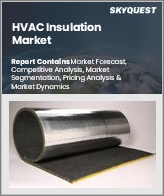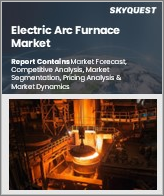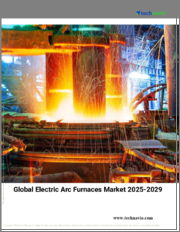
|
시장보고서
상품코드
1725070
퍼니스 필터 시장 예측(-2032년) : 필터 유형, 재료, 필터 효율, 용도, 지역별 세계 분석Furnace Filter Market Forecasts to 2032 - Global Analysis By Filter Type, Material, Filter Efficiency, Application and By Geography |
||||||
Stratistics MRC에 따르면, 세계 퍼니스 필터 시장은 2025년 59억 4,000만 달러로 예측 기간 동안 CAGR 5.2%로 성장하여 2032년에는 84억 7,000만 달러에 달할 것으로 예상됩니다.
퍼니스 필터는 난방, 환기 및 공조(HVAC) 시스템에서 중요한 부품으로, 먼지, 분진, 알레르겐 및 기타 공기 중의 입자가 퍼니스에 들어가기 전 또는 가정이나 건물 전체에 순환하기 전에 포집하도록 설계되어 있습니다. 퍼니스 필터는 퍼니스 내부 부품을 손상으로부터 보호하고 깨끗한 공기 흐름을 유지하여 시스템 성능을 보장합니다. 또한 실내 공기의 질을 개선하여 쾌적하고 건강한 공간을 만들어 줍니다. 유리섬유, 주름, 정전기, HEPA 필터 등 다양한 유형의 퍼니스 필터는 특정 요구 사항에 따라 여과 효율의 정도가 다릅니다.
미국냉난방공조협회(ASHRAE)에 따르면, 최소효율보고값(MERV) 13의 퍼니스 필터는 0.3-1.0 미크론의 입자를 최소 50% 이상 포집할 수 있으며, 그 이상의 입자에 대해서는 더 높은 비율로 포집할 수 있습니다.
HVAC 시스템 설치 증가
HVAC(난방, 환기, 공조) 시스템 설치는 주거용 아파트, 복합업무시설, 의료시설, 산업용 빌딩의 건설이 증가함에 따라 보편화되어 가고 있습니다. 최신 HVAC 시스템에는 실내 공기질과 시스템 효율을 유지하기 위해 고성능의 전용 퍼니스 필터가 자주 요구되고 있습니다. 또한, 전 세계적으로 스마트홈과 에너지 효율이 높은 건물이 확산되고 있으며, 이는 HVAC의 채택을 가속화하여 퍼니스 필터 시장에 이익을 가져다주고 있습니다.
높은 유지보수 및 교체 비용
퍼니스 필터는 실내 공기질과 HVAC 시스템의 효율성을 유지하는 데 매우 중요하지만, 특히 HEPA 필터나 정전기 필터와 같은 고효율 모델의 경우 정기적으로 구입하고 교체하는 데 비용이 많이 듭니다. 가정이나 상업용 건물의 여러 HVAC 시스템에 대한 누적 비용은 장기적으로 상당한 금액이 될 수 있습니다. 또한, 일부 소비자에게는 퍼니스 필터가 일회성 투자가 아닌 지속적인 지출로 인식되어 잦은 교체 및 업그레이드를 기피하고, 특히 가격에 민감한 시장에서는 시장 성장을 제한할 수 있습니다.
지능형 네트워크 필터에 대한 관심 증대
공기질과 필터의 건강 상태를 실시간으로 추적하는 센서가 장착된 스마트 퍼니스 필터 시장은 스마트홈의 출현과 IoT(사물인터넷)의 통합으로 확대되고 있습니다. 이러한 필터는 교체가 필요한 시기를 사용자에게 알려줌으로써 HVAC 성능을 극대화하고 시스템 수명을 연장할 수 있습니다. 또한, 자동화, 편의성, 예방적 유지보수에 가치를 두는 기술에 정통한 프리미엄 고객층은 커넥티드 앱 통합형 퍼니스 필터를 개발하기 위해 투자하는 제조업체가 확보할 수 있습니다.
치열한 가격 경쟁
경쟁이 치열해지는 퍼니스 필터 시장에서 많은 기업들이 다양한 가격대의 동등한 제품을 제공하고 있습니다. 유명 브랜드의 경우 이 치열한 가격 경쟁은 이윤율을 떨어뜨립니다. 또한 기업은 경쟁력을 유지하기 위해 가격 인하와 할인을 자주 실시해야 하며, 그 결과 재정적 안정을 유지하고 연구 개발 및 기술 혁신에 투자하는 능력에 영향을 미칠 수 있습니다.
COVID-19의 영향:
COVID-19 전염병은 퍼니스 필터 시장에 여러 가지 영향을 미쳤습니다. 초기에는 생산 지연, 노동력 부족, 공급망 혼란으로 인해 생산과 유통이 지연되어 일시적인 시장 혼란이 발생했습니다. 그러나 실내 공기의 질에 대한 사람들의 인식이 높아지고 환기가 바이러스 확산을 막는 역할을 하게 되면서 HEPA 및 정전기 모델과 같은 고효율 노내 필터에 대한 수요가 상업, 주거 및 의료 분야에서 증가했습니다. 또한, 팬데믹은 정액제 필터 서비스, 스마트홈 통합 등의 개발을 가속화하여 시장 진입 기업들에게 경제의 불확실성에도 불구하고 시장 확대의 새로운 기회를 제공했습니다.
HEPA 필터 분야는 예측 기간 동안 가장 큰 시장이 될 것으로 예상됩니다.
HEPA 필터 분야는 예측 기간 동안 가장 큰 시장 점유율을 차지할 것으로 예상됩니다. 먼지, 꽃가루, 반려동물의 비듬, 심지어 박테리아나 연기와 같은 작은 입자까지 다양한 공기 중의 입자를 포집할 수 있는 고효율 미립자 공기(HEPA) 필터는 실내 공기질을 개선하는 탁월한 능력으로 인해 가정용, 상업용, 산업용 용광로 시스템에 널리 사용되고 있습니다. 실내 공기의 질을 향상시키는 탁월한 능력 때문입니다. 또한, HEPA 필터는 0.3 미크론 이하의 입자를 99.97% 제거할 수 있기 때문에 공기 질이 중요한 용광로 응용 분야에서 인기 있는 선택이며, 더 깨끗하고 건강한 공기를 보장합니다.
예측 기간 동안 합성섬유 분야가 가장 높은 CAGR을 기록할 것으로 예상됩니다.
예측 기간 동안 합성섬유 분야가 가장 높은 성장률을 보일 것으로 예상됩니다. 이러한 급성장의 배경에는 습기에 강하고 내구성이 뛰어나며 미립자를 포집하는 효과가 있어 고성능 용도에 적합하기 때문입니다. 합성섬유 필터는 기존 소재에 비해 여과 능력이 향상되고 수명이 길기 때문에 주거용 및 상업용 HVAC 시스템 모두에서 인기가 높아지고 있습니다. 또한, 에너지 효율과 실내 공기질에 대한 관심이 높아짐에 따라 합성섬유 필터에 대한 수요가 더욱 증가하여 변화하는 퍼니스 필터 시장에서 가장 중요한 선택이 되고 있습니다.
가장 큰 점유율을 차지하는 지역
예측 기간 동안 북미가 가장 큰 시장 점유율을 차지할 것으로 예상됩니다. 고효율 HVAC 시스템의 보급, 엄격한 실내 공기질 규제, 주거 및 상업 부문 모두에서 에너지 효율이 높은 솔루션에 대한 관심이 높아진 것이 이러한 우위를 점하는 이유 중 일부입니다. 특히 미국 시장은 필터 기술의 발전과 더 나은 공기 환경이 가져다주는 건강상의 이점에 대한 소비자의 인식이 높아짐에 따라 크게 성장하고 있습니다. 또한, 이 지역에서의 강력한 시장 입지는 건설 부문의 성장과 산업 등급 여과 시스템에 대한 수요 증가의 결과이기도 합니다.
CAGR이 가장 높은 지역:
예측 기간 동안 아시아태평양은 가장 높은 CAGR을 보일 것으로 예상됩니다. 중국, 인도, 동남아시아 등의 국가에서 급속한 도시화, 건설 증가, HVAC 시스템에 대한 수요 증가가 이러한 성장의 주요 원인입니다. 엄격한 환경 규제와 실내 공기질에 대한 인식이 높아지면서 고효율 필터의 채택이 증가하고 있습니다. 또한, 이 분야의 강력한 시장 성장은 산업 부문의 시장 개척과 청정 공기 솔루션에 대한 수요 증가의 결과이기도 합니다. 그 결과, APAC는 세계 퍼니스 필터 시장에서 이 기간 동안 가장 빠른 성장률을 보일 것으로 예상됩니다.
무료 커스터마이징 서비스
본 보고서를 구독하는 고객에게는 다음과 같은 무료 맞춤화 옵션 중 하나를 제공합니다:
- 기업 소개
- 추가 시장 기업 종합 프로파일링(최대 3개사까지)
- 주요 기업 SWOT 분석(3개사까지)
- 지역 세분화
- 고객의 관심에 따른 주요 국가별 시장 추정, 예측, CAGR(주: 타당성 검토에 따른)
- 경쟁사 벤치마킹
- 제품 포트폴리오, 지리적 입지, 전략적 제휴를 기반으로 한 주요 기업 벤치마킹
목차
제1장 주요 요약
제2장 서문
- 개요
- 이해관계자
- 조사 범위
- 조사 방법
- 데이터 마이닝
- 데이터 분석
- 데이터 검증
- 조사 접근법
- 조사 자료
- 1차 조사 자료
- 2차 조사 정보 출처
- 가정
제3장 시장 동향 분석
- 성장 촉진요인
- 성장 억제요인
- 기회
- 위협
- 용도 분석
- 신흥 시장
- COVID-19의 영향
제4장 Porter's Five Forces 분석
- 공급 기업의 교섭력
- 구매자의 교섭력
- 대체품의 위협
- 신규 참여업체의 위협
- 경쟁 기업 간의 경쟁 관계
제5장 세계의 퍼니스 필터 시장 : 필터 유형별
- 정전 필터
- 유리섬유 필터
- 활성탄 필터
- 폴리에스테르 필터
- HEPA 필터
- 기타 필터 유형
제6장 세계의 퍼니스 필터 시장 : 재료별
- 유리섬유
- 합성섬유
- 금속 메시
- 종이
제7장 세계의 퍼니스 필터 시장 : 필터 효율별
- 저효율
- 중간 효율
- 고효율
제8장 세계의 퍼니스 필터 시장 : 용도별
- 주택
- 상업용
- 산업
제9장 세계의 퍼니스 필터 시장 : 지역별
- 북미
- 미국
- 캐나다
- 멕시코
- 유럽
- 독일
- 영국
- 이탈리아
- 프랑스
- 스페인
- 기타 유럽
- 아시아태평양
- 일본
- 중국
- 인도
- 호주
- 뉴질랜드
- 한국
- 기타 아시아태평양
- 남미
- 아르헨티나
- 브라질
- 칠레
- 기타 남미
- 중동 및 아프리카
- 사우디아라비아
- 아랍에미리트
- 카타르
- 남아프리카공화국
- 기타 중동 및 아프리카
제10장 주요 발전
- 계약, 파트너십, 협업, 합작투자
- 인수와 합병
- 신제품 발매
- 사업 확대
- 기타 주요 전략
제11장 기업 개요
- Camfil AB
- Eaton
- Parker Hannifin Corporation
- 3M
- Honeywell International Inc.
- Lennox Inc
- Donaldson Company, Inc.
- Koch Filter Corporation
- Mann+Hummel Inc
- AAF International
- Freudenberg Filtration Technologies
- Atlas Copco Inc
- Nordic Pure Inc
- CECO Environmental Inc
According to Stratistics MRC, the Global Furnace Filter Market is accounted for $5.94 billion in 2025 and is expected to reach $8.47 billion by 2032 growing at a CAGR of 5.2% during the forecast period. A furnace filter is a crucial component in heating, ventilation, and air conditioning (HVAC) systems, designed to trap dust, dirt, allergens, and other airborne particles before they enter the furnace or are circulated throughout a home or building. Furnace filters help shield the furnace's internal parts from harm and guarantee system performance by preserving clean airflow. Additionally, they help to improve indoor air quality, which makes places cozier and healthier. Different types of furnace filters, such as fiberglass, pleated, electrostatic, and HEPA filters, offer varying degrees of filtration efficiency based on particular requirements.
According to the American Society of Heating, Refrigerating and Air-Conditioning Engineers (ASHRAE), furnace filters with a Minimum Efficiency Reporting Value (MERV) rating of 13 are capable of capturing at least 50% of particles in the size range of 0.3 to 1.0 microns, and higher percentages for larger particles.
Market Dynamics:
Driver:
Increase in the installation of HVAC systems
Installing HVAC (heating, ventilation, and air conditioning) systems is becoming more common as more residential apartments, business complexes, medical facilities, and industrial buildings are being built. High-performance, specialized furnace filters are frequently needed for modern HVAC systems in order to preserve indoor air quality and system efficiency. Moreover, smart homes and energy-efficient buildings are becoming more and more popular worldwide, which is speeding up HVAC adoption and benefiting the furnace filter market.
Restraint:
Expensive upkeep and replacement expenses
Furnace filters are crucial for preserving the quality of indoor air and the effectiveness of HVAC systems, but they can be expensive to buy and replace on a regular basis, especially for high-efficiency models like HEPA or electrostatic filters. Over time, the cumulative costs of multiple HVAC systems in homes and commercial buildings can be substantial. Furthermore, furnace filters are perceived by some consumers as an ongoing expense rather than a one-time investment, which can discourage frequent replacement or upgrades and limit market growth, particularly in price-sensitive markets.
Opportunity:
Growing interest in intelligent and networked filters
A growing market for smart furnace filters with sensors that track air quality and filter health in real-time is being created by the emergence of smart homes and IoT (Internet of Things) integration. These filters can maximize HVAC performance and prolong system lifespan by informing users when replacements are necessary. Moreover, a premium, tech-savvy customer base that values automation, convenience, and preventative maintenance can be reached by manufacturers who make the investment to create connected and app-integrated furnace filters.
Threat:
Tough competition on prices
There are many companies offering comparable products at varying price points in the increasingly competitive furnace filter market. For well-known brands, this fierce price competition can reduce profit margins, particularly from low-cost manufacturers situated in nations with cheaper production costs. Additionally, businesses frequently have to cut prices or give discounts in order to remain competitive, which can have an effect on their ability to remain financially stable and make investments in R&D and innovation.
Covid-19 Impact:
The COVID-19 pandemic affected the furnace filter market in a variety of ways. Manufacturing slowdowns, labour shortages, and supply chain disruptions initially caused production and distribution delays, which created temporary market difficulties. But as people became more conscious of the quality of indoor air and the role ventilation plays in stopping the spread of viruses, demand for high-efficiency furnace filters-like HEPA and electrostatic models-rose in the commercial, residential, and healthcare sectors. Furthermore, the pandemic sped up developments like subscription-based filter services and smart home integration, providing market participants with fresh chances for expansion in spite of the economic uncertainty.
The HEPA filters segment is expected to be the largest during the forecast period
The HEPA filters segment is expected to account for the largest market share during the forecast period. A wide variety of airborne particles, such as dust, pollen, pet dander, and even smaller ones like bacteria and smoke, can be captured by High-Efficiency Particulate Air (HEPA) filters. Their extensive use in furnace systems for homes, businesses, and industries is largely due to their exceptional ability to improve indoor air quality. Moreover, HEPA filters are a popular option in furnace applications where air quality is essential because of their ability to remove 99.97% of particles as small as 0.3 microns, ensuring cleaner and healthier air.
The synthetic fiber segment is expected to have the highest CAGR during the forecast period
Over the forecast period, the synthetic fiber segment is predicted to witness the highest growth rate. This surge is fueled by its exceptional resilience to moisture, durability, and fine particle trapping effectiveness, which make it perfect for high-performance applications. Because of their improved filtration capabilities and longer lifespan when compared to traditional materials, synthetic fiber filters are becoming more and more popular in both residential and commercial HVAC systems. Additionally, demand for synthetic fiber filters is further driven by the increased focus on energy efficiency and indoor air quality, making them a top option in the changing furnace filter market.
Region with largest share:
During the forecast period, the North America region is expected to hold the largest market share. The widespread use of high-efficiency HVAC systems, strict indoor air quality regulations, and an increasing focus on energy-efficient solutions in both the residential and commercial sectors are some of the reasons for this dominance. Due to improvements in filter technologies and growing consumer awareness of the health advantages of better air quality, the U.S. market in particular is expanding significantly. Furthermore, the strong market presence in the area is a result of the growth of the construction sector and the increased need for industrial-grade filtration systems.
Region with highest CAGR:
Over the forecast period, the Asia Pacific region is anticipated to exhibit the highest CAGR. Rapid urbanization, an increase in construction, and a growing need for HVAC systems in nations like China, India, and Southeast Asia are the main causes of this growth. High-efficiency filter adoption is also being fueled by strict environmental regulations and increased awareness of indoor air quality. Moreover, the strong market growth in this area is also a result of the development of industrial sectors and the rising demand for clean air solutions. As a result, APAC is expected to have the fastest growth rate in the global furnace filter market during this time.
Key players in the market
Some of the key players in Furnace Filter Market include Camfil AB, Eaton, Parker Hannifin Corporation, 3M, Honeywell International Inc., Lennox Inc, Donaldson Company, Inc., Koch Filter Corporation, Mann+Hummel Inc, AAF International, Freudenberg Filtration Technologies, Atlas Copco Inc, Nordic Pure Inc and CECO Environmental Inc.
Key Developments:
In March 2025, Intelligent power management company Eaton announced it has signed an agreement to acquire Fibrebond Corporation, a designer and builder of pre-integrated modular power enclosures for data center, industrial, utility and communications customers. Under the terms of the agreement, Eaton will pay $1.4 billion for the acquisition of Fibrebond, which is expected to generate $110 million of estimated 2025 adjusted EBITDA.
In December 2024, 3M and US Conec Ltd. have entered into a strategic licensing agreement for 3M Expanded Beam Optical Interconnect technology, aimed at enhancing performance and scalability for next-generation data centers and advanced network architectures. This collaboration merges 3M's optical innovations with US Conec's expertise in high-density connectivity solutions.
In July 2024, Parker Hannifin Corporation announced it has signed an agreement to divest its North America Composites and Fuel Containment (CFC) Division to private investment firm SK Capital Partners. With the completion of this transaction the company will have successfully divested businesses and product lines over the past three years that total nearly $450 million in annual sales.
Filter Types Covered:
- Electrostatic Filters
- Fiberglass Filters
- Activated Carbon Filters
- Polyester Filters
- HEPA Filters
- Other Filter Types
Materials Covered:
- Fiberglass
- Synthetic Fiber
- Metal Mesh
- Paper
Filter Efficiencies Covered:
- Low Efficiency
- Medium Efficiency
- High Efficiency
Applications Covered:
- Residential
- Commercial
- Industrial
Regions Covered:
- North America
- US
- Canada
- Mexico
- Europe
- Germany
- UK
- Italy
- France
- Spain
- Rest of Europe
- Asia Pacific
- Japan
- China
- India
- Australia
- New Zealand
- South Korea
- Rest of Asia Pacific
- South America
- Argentina
- Brazil
- Chile
- Rest of South America
- Middle East & Africa
- Saudi Arabia
- UAE
- Qatar
- South Africa
- Rest of Middle East & Africa
What our report offers:
- Market share assessments for the regional and country-level segments
- Strategic recommendations for the new entrants
- Covers Market data for the years 2024, 2025, 2026, 2028, and 2032
- Market Trends (Drivers, Constraints, Opportunities, Threats, Challenges, Investment Opportunities, and recommendations)
- Strategic recommendations in key business segments based on the market estimations
- Competitive landscaping mapping the key common trends
- Company profiling with detailed strategies, financials, and recent developments
- Supply chain trends mapping the latest technological advancements
Free Customization Offerings:
All the customers of this report will be entitled to receive one of the following free customization options:
- Company Profiling
- Comprehensive profiling of additional market players (up to 3)
- SWOT Analysis of key players (up to 3)
- Regional Segmentation
- Market estimations, Forecasts and CAGR of any prominent country as per the client's interest (Note: Depends on feasibility check)
- Competitive Benchmarking
- Benchmarking of key players based on product portfolio, geographical presence, and strategic alliances
Table of Contents
1 Executive Summary
2 Preface
- 2.1 Abstract
- 2.2 Stake Holders
- 2.3 Research Scope
- 2.4 Research Methodology
- 2.4.1 Data Mining
- 2.4.2 Data Analysis
- 2.4.3 Data Validation
- 2.4.4 Research Approach
- 2.5 Research Sources
- 2.5.1 Primary Research Sources
- 2.5.2 Secondary Research Sources
- 2.5.3 Assumptions
3 Market Trend Analysis
- 3.1 Introduction
- 3.2 Drivers
- 3.3 Restraints
- 3.4 Opportunities
- 3.5 Threats
- 3.6 Application Analysis
- 3.7 Emerging Markets
- 3.8 Impact of Covid-19
4 Porters Five Force Analysis
- 4.1 Bargaining power of suppliers
- 4.2 Bargaining power of buyers
- 4.3 Threat of substitutes
- 4.4 Threat of new entrants
- 4.5 Competitive rivalry
5 Global Furnace Filter Market, By Filter Type
- 5.1 Introduction
- 5.2 Electrostatic Filters
- 5.3 Fiberglass Filters
- 5.4 Activated Carbon Filters
- 5.5 Polyester Filters
- 5.6 HEPA Filters
- 5.7 Other Filter Types
6 Global Furnace Filter Market, By Material
- 6.1 Introduction
- 6.2 Fiberglass
- 6.3 Synthetic Fiber
- 6.4 Metal Mesh
- 6.5 Paper
7 Global Furnace Filter Market, By Filter Efficiency
- 7.1 Introduction
- 7.2 Low Efficiency
- 7.3 Medium Efficiency
- 7.4 High Efficiency
8 Global Furnace Filter Market, By Application
- 8.1 Introduction
- 8.2 Residential
- 8.3 Commercial
- 8.4 Industrial
9 Global Furnace Filter Market, By Geography
- 9.1 Introduction
- 9.2 North America
- 9.2.1 US
- 9.2.2 Canada
- 9.2.3 Mexico
- 9.3 Europe
- 9.3.1 Germany
- 9.3.2 UK
- 9.3.3 Italy
- 9.3.4 France
- 9.3.5 Spain
- 9.3.6 Rest of Europe
- 9.4 Asia Pacific
- 9.4.1 Japan
- 9.4.2 China
- 9.4.3 India
- 9.4.4 Australia
- 9.4.5 New Zealand
- 9.4.6 South Korea
- 9.4.7 Rest of Asia Pacific
- 9.5 South America
- 9.5.1 Argentina
- 9.5.2 Brazil
- 9.5.3 Chile
- 9.5.4 Rest of South America
- 9.6 Middle East & Africa
- 9.6.1 Saudi Arabia
- 9.6.2 UAE
- 9.6.3 Qatar
- 9.6.4 South Africa
- 9.6.5 Rest of Middle East & Africa
10 Key Developments
- 10.1 Agreements, Partnerships, Collaborations and Joint Ventures
- 10.2 Acquisitions & Mergers
- 10.3 New Product Launch
- 10.4 Expansions
- 10.5 Other Key Strategies
11 Company Profiling
- 11.1 Camfil AB
- 11.2 Eaton
- 11.3 Parker Hannifin Corporation
- 11.4 3M
- 11.5 Honeywell International Inc.
- 11.6 Lennox Inc
- 11.7 Donaldson Company, Inc.
- 11.8 Koch Filter Corporation
- 11.9 Mann+Hummel Inc
- 11.10 AAF International
- 11.11 Freudenberg Filtration Technologies
- 11.12 Atlas Copco Inc
- 11.13 Nordic Pure Inc
- 11.14 CECO Environmental Inc



















